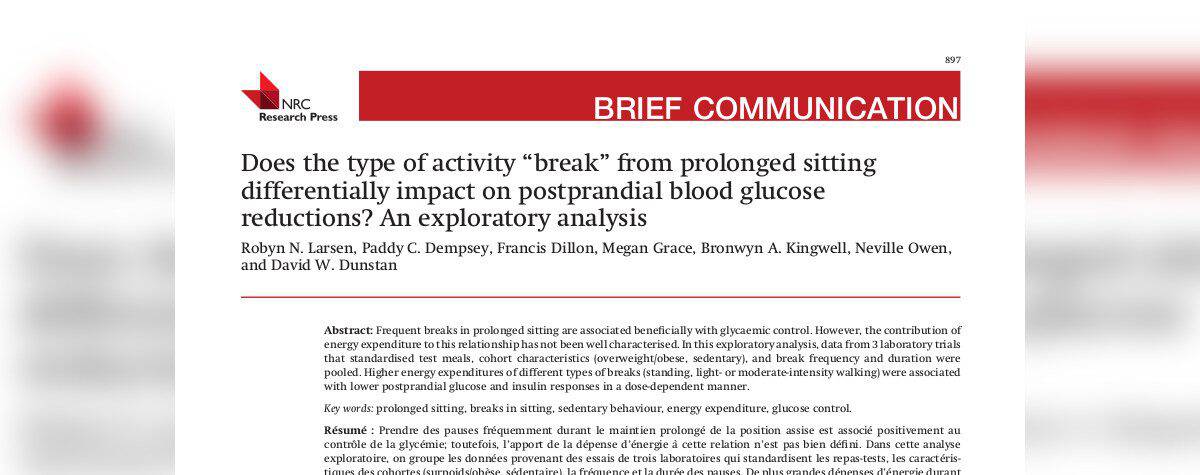
Just Stand Up
September 1, 2017
Is all screen time bad?
September 27, 2017Today’s post comes from Dr Robyn Larsen. More information on Dr Larsen can be found at the bottom of this post.
The concept of breaks in sitting time is emerging as a potential intervention strategy for managing disturbances in glucose metabolism, which increases risk of developing diabetes, cardiovascular disease and other chronic health problems. Accumulating evidence from a number of laboratory-based experimental studies suggest that regularly breaking up prolonged sitting lowers glucose and insulin levels in healthy and overweight/obese adults and in individuals with type 2 diabetes.1-5
These randomized cross-over trials show consistent detrimental effects of uninterrupted sitting, compared with sitting that has been interrupted with short bouts of standing,3 light-intensity activities,1-3, 5 or moderate-intensity walking.1
A potential mechanism linking breaks in sitting with improvements in blood glucose control is increased energy expenditure (EE). As sitting is characterised by low EE, breaks in sitting provide opportunities to accumulate EE, via increases in nonexercise activity thermogenesis. In theory, the EE of each break may be manipulated by altering the frequency, duration or intensity of the breaking activity. However, the impact of breaks in sitting in relation to varying EEs has not been previously explored.
For the purpose of future intervention development, there is a need to more clearly understand the impacts of different strategies to break up sitting, and how this relates to risk markers of cardiometabolic disease. For instance:
- What type of a break should we target to replace sitting?
- How frequently do we need to break up sitting and what duration should the breaks be?
- Do we need to target only ‘at-risk’ subgroups of the population?
Future experimental trials involving systematic “dose” manipulations of breaks in sitting are needed to inform the design and tailoring of interventions and programs.
In our recently published paper in Applied Physiology, Nutrition and Metabolism,6 we addressed the question of whether different types of breaks from prolonged sitting can differentially impact on post-meal (‘postprandial’) blood glucose and insulin levels, in a sample of participants from past trials,1, 2, 7.
We reported findings from an exploratory analysis of pooled data from of our three laboratory-based trials that standardized the test meal, cohort characteristics (overweight/obese adults) and the frequency and duration of the breaks in sitting. This included nine participants who completed laboratory trials comparing the acute effects of prolonged sitting with sitting interrupted every 20-minutes with 2-minute bouts of either standing, light-intensity and moderate-intensity physical activity. EE related to the conditions was estimated from formula-derived estimations,8, 9 as EE was not directly measured during conditions.
We found that the EE of the break in sitting was associated with the lowering of postprandial glucose and insulin responses in a dose-dependent manner. These findings suggest that the type of break from sitting may be important for improving these important metabolic responses.
Further studies on the direct measurement of EE are required to confirm our observations and to examine the effects of different “dose” manipulations to breaks in sitting, such as break frequencies, break durations and break intensities.
 Dr Robyn Larsen is a nutritional biochemist currently employed as a postdoctoral fellow in the Physical Activity and Behavioural Epidemiology Laboratories at the Baker Heart and Diabetes institute. Her current research interests include the impact of sedentary behaviours during pregnancy and risk of developing gestational diabetes mellitus (see GLOW breaks in pregnancy study).
Dr Robyn Larsen is a nutritional biochemist currently employed as a postdoctoral fellow in the Physical Activity and Behavioural Epidemiology Laboratories at the Baker Heart and Diabetes institute. Her current research interests include the impact of sedentary behaviours during pregnancy and risk of developing gestational diabetes mellitus (see GLOW breaks in pregnancy study).
REFERENCES
- Dunstan DW, Kingwell BA, Larsen R, Healy GN, Cerin E, Hamilton MT, Shaw JE, Bertovic DA, Zimmet PZ, Salmon J and Owen N. Breaking up prolonged sitting reduces postprandial glucose and insulin responses. Diabetes care. 2012;35:976-83.
- Larsen RN, Kingwell BA, Robinson C, Hammond L, Cerin E, Shaw JE, Healy GN, Hamilton MT, Owen N and Dunstan DW. Breaking up of prolonged sitting over three days sustains, but does not enhance, lowering of postprandial plasma glucose and insulin in overweight and obese adults. Clin Sci (Lond). 2015;129:117-27.
- Bailey DP and Locke CD. Breaking up prolonged sitting with light-intensity walking improves postprandial glycemia, but breaking up sitting with standing does not. J Sci Med Sport. 2015;18:294-8.
- Buckley JP, Mellor DD, Morris M and Joseph F. Standing-based office work shows encouraging signs of attenuating post-prandial glycaemic excursion. Occup Environ Med. 2014;71:109-11.
- Dempsey PC, Larsen RN, Sethi P, Sacre JW, Straznicky NE, Cohen ND, Cerin E, Lambert GW, Owen N, Kingwell BA and Dunstan DW. Benefits for Type 2 Diabetes of Interrupting Prolonged Sitting With Brief Bouts of Light Walking or Simple Resistance Activities. Diabetes care. 2016;39:964-72.
- Larsen RN, Dempsey PC, Dillon F, Grace M, Kingwell BA, Owen N and Dunstan DW. Does the type of activity “break” from prolonged sitting differentially impact on postprandial blood glucose reductions? An exploratory analysis. Appl Physiol Nutr Metab. 2017;42:897-900.
- Australian New Zealnd Clinical Trials Registry. Available at – https://www.anzctr.org.au/Trial/Registration/TrialReview.aspx?id=362652 Project title: The acute effect of breaking up prolonged sitting with intermittent bouts of short-duration standing on postprandial glucose metabolism, lipid metabolism and vascular function in overweight/obese adults. 2012.
- Ainsworth BE, Haskell WL, Whitt MC, Irwin ML, Swartz AM, Strath SJ, O’Brien WL, Bassett DR, Jr., Schmitz KH, Emplaincourt PO, Jacobs DR, Jr. and Leon AS. Compendium of physical activities: an update of activity codes and MET intensities. Medicine and science in sports and exercise. 2000;32:S498-504.
- Mifflin MD, St Jeor ST, Hill LA, Scott BJ, Daugherty SA and Koh YO. A new predictive equation for resting energy expenditure in healthy individuals. The American journal of clinical nutrition. 1990;51:241-7.




